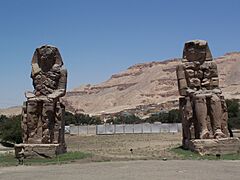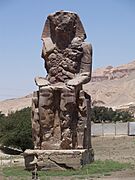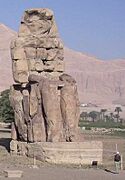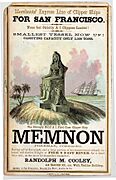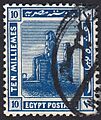Colossi of Memnon facts for kids
| Arabic: el-Colossat | |
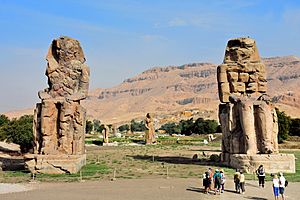
The Colossi of Memnon in 2015
|
|
| Coordinates | 25°43′14″N 32°36′38″E / 25.72056°N 32.61056°E |
|---|---|
| Location | West of Luxor |
| Type | statue |
| Material | quartzite stone |
| Height | 18 m (60 ft) |
| Completion date | 1350 BC |
| Dedicated to | Amenhotep III |
The Colossi of Memnon (Arabic: el-Colossat or es-Salamat) are two giant stone statues in Egypt. They show the ancient Egyptian ruler, Pharaoh Amenhotep III. These huge statues stand in front of what's left of his memorial temple. This temple was once the biggest in the Theban Necropolis, a famous burial ground.
The Colossi have been standing since about 1350 BC. People from ancient Greece and Rome knew about them. Even early travelers and Egyptologists (people who study ancient Egypt) found them fascinating. The statues have 107 old Roman writings on them. These writings are in Greek and Latin and date from AD 20 to 250. Many of them mention a Greek hero named Memnon. People back then mistakenly thought the northern statue was him.
Contents
The Colossi of Memnon
What Do They Look Like?
The two statues show Amenhotep III sitting down. His hands rest on his knees, and he looks towards the east. Two smaller figures are carved next to his legs on the front of his throne. These are his wife, Tiye, and his mother, Mutemwiya. On the sides of the throne, you can see carvings of Hapi, the ancient Egyptian god of the Nile River.
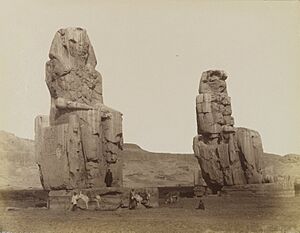
The statues are made from a type of stone called quartzite sandstone. This stone came from a quarry near modern-day Cairo. It was carried about 675 km (420 mi) overland to Thebes (which is now Luxor). The stones were too heavy to be moved by boat on the Nile River. The Colossi stand on stone platforms that are about 4 m (13 ft) tall. With these platforms, the statues reach a height of 18 m (60 ft). Each one weighs around 720 tons! The two statues are about 15 m (50 ft) apart.
Both statues are quite damaged, especially above the waist. The southern statue is made from one piece of stone. But the northern one has a big crack in its lower part. Its upper half is made of five layers of a different type of sandstone. This shows it was rebuilt later. It's thought that both statues originally looked exactly the same.
Their Original Purpose
The Colossi were built to guard the entrance to Amenhotep's memorial temple. This huge temple was built when the pharaoh was alive. People worshipped him there as a god on Earth. In its time, this temple was the biggest and most beautiful in Ancient Egypt. It covered a huge area of 35 hectares (86 acres). Even later temples, like those of Ramesses II or Ramesses III, were not as large. Even the Temple of Karnak was smaller back then.

Sadly, very little of Amenhotep's temple remains today, except for the Colossi. The temple was built near the Nile River's floodplain. Yearly floods slowly wore away its foundations. Old pictures show the Colossi surrounded by water. Also, later rulers sometimes took stones from older monuments to build their own.
Ancient Writings on the Statues
The statues have 107 ancient Roman writings on them. These are in Greek and Latin, from between 20 AD and 250 AD. These writings helped modern travelers understand the statues' history. Many of these writings mention the name "Memnon."
Earthquakes and Damage
Soon after it was built, Amenhotep's temple was damaged by an earthquake. This earthquake happened around 1200 BC. Only the two huge Colossi at the entrance were left standing. Then, another earthquake in 27 BC damaged them even more. After this, the Roman authorities tried to rebuild parts of them.
The 1200 BC earthquake also created many cracks in the ground. This buried many statues, some of them in perfect condition. Experts have been working to restore and dig up these buried treasures. They found that the temple complex had three main gates, each with giant statues. At the very end, there was a rectangular temple with columns all around it. So far, four statues have been put back up. Many more are waiting to be restored or are kept in the Luxor Museum.
Why Are They Called Memnon?
The modern Arabic name for the area is Kom el-Hatan. But the statues are mostly known by their Roman name, the Temple of Memnon. Memnon was a hero in the Trojan War. He was a king from Ethiopia who led his armies to help the city of Troy. But he was eventually killed by the hero Achilles.
Memnon's name means "the Steadfast" or "Resolute." He became linked to these statues because the northern statue was said to "sing" at dawn (see below). This statue became known as the Colossus of Memnon. Eventually, the entire Theban Necropolis was sometimes called the Memnonium. This made Memnon seem like a "Ruler of the west," similar to the god Osiris.
In the 1800s, a traveler named William de Wiveleslie Abney noted that local Arabs called the statues "Shama" and "Tama." When they spoke of them together, they called them "Sanamât," meaning "the idols."
The Singing Statues
In 27 BCE, a big earthquake reportedly broke the northern Colossus. It collapsed from the waist up, and its lower half cracked. After this damage, the remaining lower part of the statue was said to "sing" at certain times. This sound always happened within an hour or two of sunrise, usually right at dawn. The sound was most often heard in February or March. This might be because more tourists visited then.
The first written report of the sound comes from the Greek historian Strabo. He said he heard the sound during a visit in 20 BCE. By then, it was already quite famous. People described the sound differently. Strabo said it sounded "like a blow." Pausanias compared it to "the string of a lyre" breaking. Others said it sounded like striking brass or whistling. Many ancient writers, like Pliny and Tacitus, also mentioned it. The base of the statue has about 90 writings from tourists who reported hearing the sound.
The story of the "Vocal Memnon" became very famous. People believed that hearing it brought good luck. The statue was also thought to have oracular powers, meaning it could tell the future. Many visitors, including several Roman emperors, came to see the statues. The last reliable report of the sound was in 196 AD. Later, in the Roman era, the upper parts of the northern statue were rebuilt with new sandstone. The original top half was never found. This rebuilding might have stopped the sound.
People have suggested different reasons for the sound. Some think it was natural. The sound might have been caused by rising temperatures and dew evaporating inside the porous stone. Similar sounds, though much rarer, have been heard from other Egyptian monuments. The fact that the sound stopped after the statue was rebuilt suggests it was natural. The added weight of the new upper parts might have stopped the vibrations.
Some mentions of the sound in the 1700s and 1800s might have been hoaxes. These could have been made by writers or by locals trying to keep the legend alive.
The "Vocal Memnon" appears in famous stories too. It's in Henrik Ibsen's play Peer Gynt. It's also mentioned in Oscar Wilde's fairy tale "The Happy Prince." And it's referenced in Thomas Pynchon's novel V. (1963).
Images for kids
Modern images
-
Sailing card for the clipper ship Memnon
Notable historical images
-
c.1800 from Description de l'Égypte
-
c.1800 from Description de l'Égypte, showing the inscriptions
-
1851, first ever photographs, by John Beasley Greene
-
1851, first ever photographs, by John Beasley Greene
-
1851, first ever photographs, by John Beasley Greene
See also
- Colossal red granite statue of Amenhotep III
- List of largest monoliths










